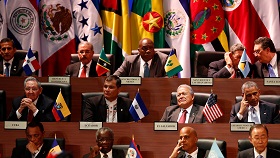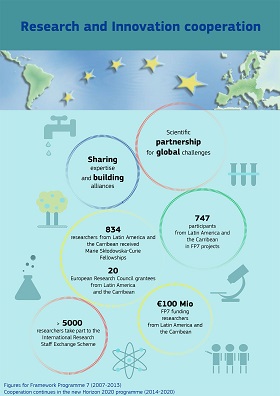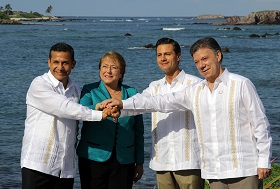This is the main question in the wake of the 8th EU-LAC summit held in Brussels on June 10-12, 2015. It is worth recalling that the first bi-regional meeting of the heads of state and government of Latin America and the Caribbean with their counterparts from the European Union was held in Rio de Janeiro in 1999. These regional summits take place every two years in order to review transcontinental cooperation and map out plans for the future. After the establishment of the Community of Latin American and Caribbean States (CELAC) by Latin American and Caribbean countries, the summit in Brussels was the second held since 2013 between the EU and CELAC, which became the EU's counterpart for the bi-regional partnership process. Thus, the Summit was co-chaired by President of the European Council Donald Tusk representing the 28 countries of the European Union, and Rafael Correa, Ecuadorian President and CELAC’s President pro-tempore, who represented 33 countries from Latin America and the Caribbean (LAC).
The CELAC members currently enjoy a higher rate of GDP growth in comparison with that of the EU countries and are setting ambitious goals of becoming one of the poles in a multipolar world. The establishment of such a multipolar international order is favored today by each and every LAC country, and the creation of the region-wide CELAC as an advisory body, similar to the earlier structures UNASUR (the Union of South American Nations) and SADC (South American Defense Council), offers additional evidence for this position. In contrast, the EU, which has not yet completely overcome the consequences of economic crisis and is now facing an identity crisis that has been particularly evident amidst developments in Ukraine, pales in significance. Moreover, on the eve of the summit, the International Organization for Migration (IOM) has published data showing that the number of migrants from Europe to LAC countries has for the first time ever exceeded the number of those who have traditionally moved in the opposite direction.
The differences between the partners on both sides of the Atlantic have become apparent at the preliminary stage, namely over the course of discussions at the EuroLat Parliamentary Assembly, which is the parliamentary institution under the Bi-regional Strategic Association established in 1999 during the EU-LAC Summits. In response to the Latin American’s appeal to put an end to US pressure on Venezuela, which has been unreservedly supported by the EU, the European Parliament Vice-President Antonio Tajani emphasized that the EU would continue to monitor the state of human rights around the world, which clearly runs counter to the foreign policy cornerstone of the leading LAC countries, i.e. the principle of non-interference in internal affairs.
At the summit of the heads of state and government from 61 countries, this issue was raised again. One of its Co-Chairs, Rafael Correa, called for the lifting of US sanctions against Venezuela, which he declared were an open violation of international law. CELAC countries put forward a proposal to include in the draft final declaration a provision criticizing the policies of US sanctions against that South American country. The other Co-Chair, Donald Tusk, chose to side-step this “inconvenient” issue by calling upon the summit participants to express support for the negotiations of the Colombian Government with FARC left-wing rebels, as well as for the “modernization process” in Cuba. On behalf of the EU, Donald Tusk offered assistance towards a post-conflict settlement in Colombia and expressed hope for an early conclusion to a political and economic agreement between Cuba and the EU.
It appears that the summit, with the rather inelegant theme of “Shaping our common future: working for prosperous, cohesive and sustainable societies for our citizens,” failed to reach expected results. The promised “new horizons” of cooperation were overshadowed by old geopolitical schemes. Its most positive result, perhaps, appears to be the EU’s promise to conclude an agreement with Cuba (the EU obviously got the green light from Washington). CELAC countries, for their part, called for an early end to the economic blockade of Cuba and declared it illegal for the United States to undertake “unilateral measures,” such as the infamous Helms-Burton Act.
The final declaration was approved unanimously and reaffirmed the “rejection of coercive measures of an unilateral character” with regard to the Bolivarian Republic of Venezuela without mentioning the United States directly. It abounded in appropriate but also general provisions on the need to respect international law, to fight intolerance, drug trafficking, terrorism and climate change, to work out new approaches to cooperation in the spheres of science and education and so on.
The current situation in Latin America and the Caribbean urgently requires new and vigorous efforts on the part of the US and its European allies. The blatant disregard of the interests of this rising region by several US administrations and by European countries has inevitably resulted in a widening of the gap between this region and the structures of the “collective West.” The collapse of the Free Trade Area of the Americas (FTAA) project, the decline of the Organization of American States (OAS), the “left turn” in a number of countries in the region, the enhanced role of Brazil as a potential leader of the “Hispanic bloc,” and the establishment of collective Latin American structures, including in the security sector, also testify to this.
In the international arena, leading LAC countries on the one hand and the United States with its European allies on the other hand have increasingly often found themselves on opposite sides of the barricades. The peoples of Latin America and the Caribbean have acquired alternative directions for cooperation: China, BRICS, and the Asia-Pacific region. And while the US is still the main trade partner for LAC countries, China has become the leading trade partner of Brazil, Chile and Peru, and ranks second in trade with Mexico and Argentina, while its investments in the region are growing like a rolling snowball.
The United States was the first to realize that something had to be urgently done to right the ship; this happened at the beginning of the second term of Barack Obama’s presidency. The most telling gesture on the part of the US was its promise to restore diplomatic relations with Cuba (a complete lifting of economic sanctions is not yet on the agenda). Sanctions against Cuba, imposed back in the 1960s, have long marred US relations with the whole region of Latin America and the Caribbean, and many US analysts regard them as counterproductive. However, many observers have immediately noted the dual nature of American initiatives, qualifying them as an attempt to combine the new with the old: while announcing the normalization of relations with Cuba, Washington calls Venezuela a “threat to the US” just as it did in the 1960s, launching an undeclared war against Liberty Island.
At the same time, the United States is undertaking efforts to split the CELAC and the emerging Latin-Caribbean bloc by promoting certain Latin American integration projects to the detriment of others. The most dynamic of them today is the Pacific Alliance (PA) established in 2013, and its members are Mexico, Colombia, Chile and Peru [1]. In contrast to Mercosur with its informal leadership of Brazil, membership for Venezuela and strong Latin American ideological values, the Pacific Alliance is more focused on economic and trade cooperation as well as on liberal values, although all its member states are members of UNASUR, CELAC and SADC as well. The US is trying to use the competition between the two integration models within a single region to strike a blow at Mercosur and indirectly at Brazil as the leader of the region-wide processes. Another goal of Washington’s is to slow down LAC counties’ growing cooperation with China and Russia. To this end, it is inviting PA members to join the initiated Trans-Pacific Partnership (TTP), which has been initiated by the US and does not plan to include either Russia or China.
Brazil, just as such BRICS members as Russia and China, is becoming increasingly aware of the military presence of the West close to its borders. In the case of Brazil, this refers to NATO bases on Ascension Island, in the Falkland Islands (Malvinas) in the South Atlantic, which is a British overseas territory, and US bases in Colombia, established there under the pretext of fighting drug trafficking. The concern of the largest Latin American country over these developments has resulted in the adoption of a new defensive doctrine, which provides for the creation of modern armed forces using advanced technology.
At the summit in Brussels, the EU announced plans to grant a visa-free regime to citizens of the two PA country-members, namely Colombia and Peru, although the peace talks in the former are far from nearing an end, and to render financial assistance to Columbia, which in the current context can be considered as the European Union's unconditional support of Washington’s geopolitical games in Latin America. As for the other members of the Pacific Alliance, Mexico and Chile, the EU has promised them that it would “modernize” previously concluded trade agreements.
In contrast, the EU’s relations with Mercosur and particularly with Brazil, which the EU proclaimed as its strategic partner back in 2007 (Mexico received this status in 2009), have not got off the dime yet. The planned agreement on a Mercosur-EU free trade zone has stagnated since 2005 due to Europeans’ unwillingness to stop subsidizing their agricultural sector. A comprehensive economic and trade agreement between Brazil and the EU has not been concluded, although Brazil accounts for 75% of the exports of Mercosur member countries to the European market, while the share of Mercosur exports is about half of LAC countries' total exports to the European market. However, the final declaration of the EU-CELAC Summit, as well as a number of earlier declarations and communiqués, expressed hope that the EU-Mercosur trade agreement will be signed as soon as possible.
There is little doubt that the European Union, just as the US, would also like the Pacific Alliance rather than Mercosur to lead integration processes in Latin America and the Caribbean, and prefers a more manageable Mexico to independent Brazil (although both of these Latin American countries are members of G20, and Mexico's GDP is slightly smaller than Brazil’s). The way the cards fall in this geopolitical game will largely depend on the visit of Brazilian President Dilma Rousseff in Washington scheduled for July. The visit was canceled back in the day due to the scandal caused by Edward Snowden’s exposure of extensive Internet and phone surveillance by American intelligence.
The EU’s promise to allocate €800 million for development projects in LAC countries was the final chord of the summit. Given the identified geopolitical preferences of “united Europe,” we have every reason to assume which countries will become the main beneficiaries of this monetary transaction. A decision to hold foreign ministers’ meetings of EU and CELAC countries on an annual basis only reflects Brussels’ aspiration to monitor rigorously the situation in this obstinate region. At the final stage of the Summit President of the European Council Donald Tusk put on a brave face, saying that it "is not always important to reach an agreement, it is much more important to understand each other better.”
1. Costa Rica became a member of the Pacific Alliance in 2015.








